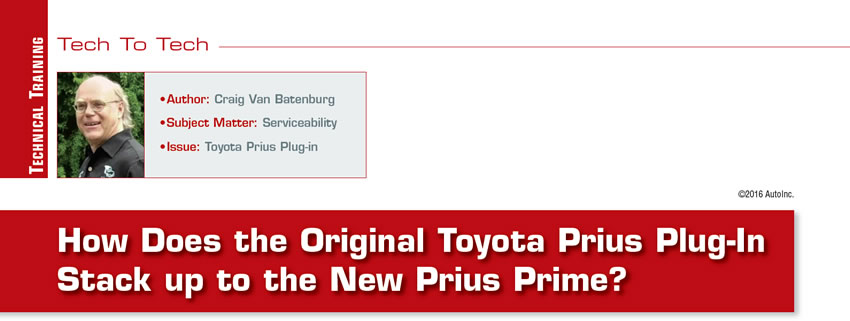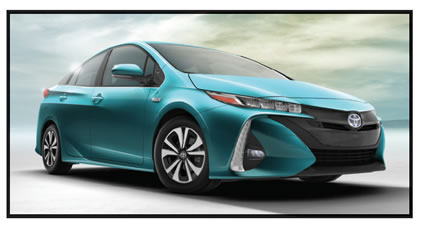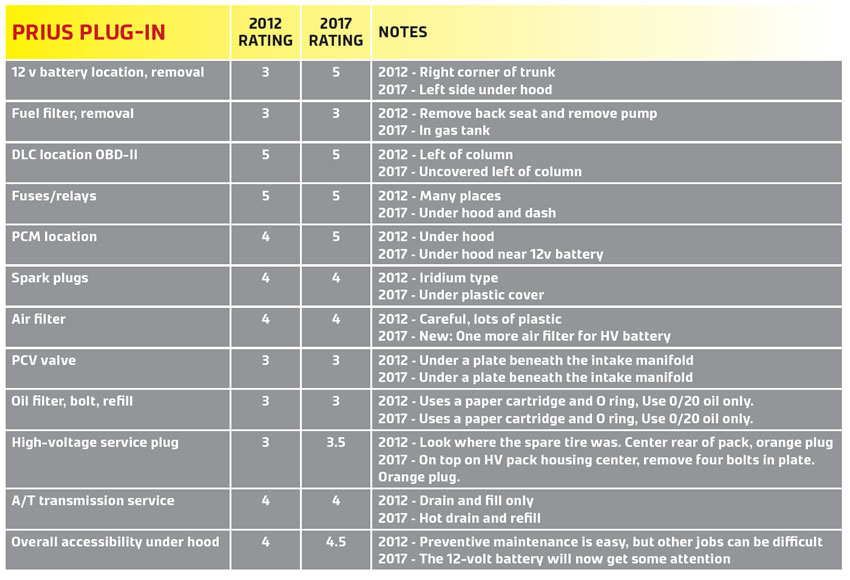
Tech to Tech
- Author: Craig Van Batenburg
- Subject Matter: Serviceability
- Issue: Toyota Prius Plug-in
Serviceability Report
Twenty years ago this December, the Prius was introduced to the world. Three years later, it came to America and the quintessential hybrid was born.

Everyone has heard of Prius. The Plug-in Prius came out in model year (M/Y) 2012 but never sold in large numbers. Now, an all-new Prius Plug-in is here, and Toyota calls it the Prime. I’ve been working on, driving and teaching Prius classes since the beginning, and a lot has changed since then.
The Prius family (Prius Hatchback, Prius C, Prius V and the new Prime) is still popular. When the engineers changed the plug-in model technically, did they make it easier or harder to service and repair? We’ll find out.
2012 Prius Plug-in
The 2012 Toyota Prius Plug-in Hybrid was the first attempt at adding the plug-in capability. Many aftermarket companies had kits available prior to that, and many Prius owners had them installed. But the market for aftermarket kits has since dried up.

If you drive slowly on flat roads, this is a true electric vehicle (EV) in operation for up to 15 miles at speeds up to 62 mph. But for most drivers, the range was too short and the internal combustion engine (ICE) runs while driving. So for drivers who didn’t want to use gasoline, this car didn’t provide what they wanted. In M/Y 2015, the Prius Plug-in was discontinued.
The 2012 Prius Plug-in Hybrid retained the Hybrid Synergy Drive of the standard Prius and added a 4.4 kWh lithium-ion (Li-ion) battery pack that replaced the smaller nickel metal hydride (NiMH) battery. It’s located where you would find a spare tire, along with the onboard charger and the electric vehicle supply equipment (EVSE). A full charge, using a 120-volt outlet, takes about three hours (1.5 hours using a 240-volt plug). The onboard battery charger system and Li-ion battery pack added hundreds of pounds to the plug-in, but the car is only 123 pounds heavier than the standard Prius liftback, thanks to the use of aluminum in the hood, rear hatch, front stabilizer bar, brake calipers and by using super high-tensile strength steel in the inner rocker panel, center pillar and roof reinforcement.
Toyota developed the new battery specifically for the Plug-in. The 4.4 kWh battery pack includes a battery charger located under the main battery that features an internal cooling fan. The Hybrid system’s inverter has been modified for the new, higher-capacity battery. In addition, its cooling system uses a larger heat exchanger and higher-capacity fan motor.

The Hybrid Synergy Drive system in the Prius Plug-in hybrid is essentially the same as in the current third-generation Prius. The system uses two electric motors inside the transaxle. The larger motor (60 kW or 80 hp) powers the car in EV mode. Maximum motor-drive voltage is 650 volts DC. For quick interior heating in cold climates, it features standard two-position, front-seat heaters and a supplementary electric heater. The 80hp electric motor is not powerful enough to move the car without the ICE at higher speeds or under high loads. The first-generation Volt has an 111kw (149 hp) electric motor, for comparison.
The problems associated with this car are the same as the non-plug-in model and well documented. This car had three recalls – a label on the car did not reflect the weight; side-curtain air bags were recalled; and some EGR valves were sticky – so the warranty on those was extended. Overall, it was a good car but owners were not impressed with the electric range.
2017 Prius Prime
One look under the hood on a Prius Prime, and you’ll see a Generation IV Prius. The 12-volt battery is in plain view, a plastic cover hides the ICE and many aluminum lines move back and forth from the high-voltage electric A/C compressor, doing double duty to offer heat in cold weather. The entire car is new and the plug-in version has more range, but unlike the Chevy Volt, the Prime will start the ICE more often. There are many switchable modes you can use while driving.
The Prime is going after the Volt with a better product. It’s selling quite well in the United States, and some states, like Massachusetts, offer rebates when you buy or lease a plug-in car. In fact, it’s less expensive in some areas to buy the Prime than it is a Prius non-plug-in.
The hybrid plug-in sector grew 50% in calendar year 2015, with sales in 2016 also strong. Most forecasts show the hybrid plug-in sales continuing to grow in the future. I suggest you take this segment seriously and get familiar, add a charging station at your shop and look at owning one as the off-lease cars are selling at extremely low prices as of this writing (March 2017).
The transaxle, ICE, frame and body, suspension and high-voltage battery are all new. The jack handle and oil cap may be a holdover. A new dual-motor hybrid powertrain has an estimated 133 mpg equivalent and was the highest rated in the industry among all vehicles until the recent debut of the Hyundai Ionic EV. In hybrid mode, the Prius Prime stands out again, exceeding all competitors’ fuel economy ratings with EPA-estimated 55 city/53 highway/54 combined mpg.
The Prime has an EPA-estimated electric range of up to 25 miles and up to 84 mph in EV mode, with the goal of meeting the daily commuting distance of more than half of U.S. drivers.

Prime engineering
Weight savings come from a Toyota-made, lightweight carbon-fiber rear hatch. Automatic grille shutters help reduce drag by closing when airflow to the radiator is not needed.
Also available are Predictive Efficient Drive and Predictive Deceleration Support, which collect daily driving data to predict points of deceleration and stopping. From then on, when the driver goes through a location in the database, the system indicates when to let off on the accelerator and apply assisted deceleration to help boost fuel efficiency.
The driveline
Both the standard Prius Hybrid and the Prius Prime are powered by Toyota’s Hybrid Synergy Drive powertrain. The biggest difference is that the Prius Prime can be plugged in to recharge its larger 8.8 kWh lithium-ion battery pack – more than double that of the Prius Plug-in Hybrid it replaced.
On cold days, a battery warmer activates at the completion of a charge to keep the drive battery temperature above 32° Fahrenheit, ensuring that it can deliver optimal EV performance and range when the vehicle is started.
The major change to the CVT, which Toyota pioneered 20 years ago, is a system that uses both MG1 and MG2 to drive the wheels and a new one-way clutch. MG1 can now add power to the ring gear through the carrier. This was originally designed into the prototype Prius but never used. Better late than never.
The 1.8-liter Atkinson-cycle, 4-cylinder engine, used in all 2016-17 Prius liftback models (not the C or V) has a high thermal efficiency (as high as 40 percent). Most modern automobile engines reach about 20-25 percent.
Summary
Are plug-in hybrids more difficult to service than ordinary hybrids? There are more parts and more contactors in the high-voltage battery system. Charging off the grid is new, and the HVAC is very complex. If you’re not new to hybrid systems, this learning curve is uphill but it will not wear you out. On the other hand, if you’ve stayed away from hybrid cars, stop waiting. It only gets harder when you wait.
The Automotive Service Excellence’s (ASE) L3 test has added a plug-in part to the hybrid test in early 2017. Going electric is popular and doable. Car owners are waking up to that, and they will need you.
Overall, the Prius Prime is easier for a tech to service than the earlier model, but not by much. Toyota could use input from their technicians to improve their designs. I work with engineers, and the good ones know the difficulty we have servicing and repairing what they’ve designed. Honda R&D in Raymond, Ohio, and ACDC worked together a couple of years back. We worked on some “yet to be sold” products, and your future is looking better.














